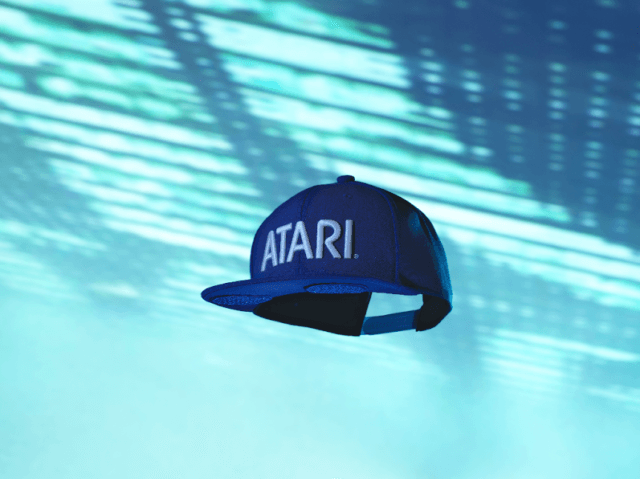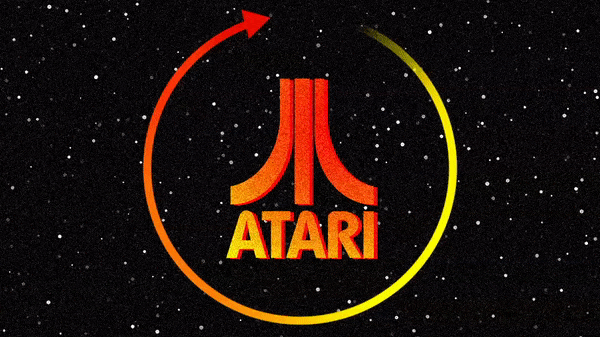Thirty-five years have passed since Blade Runner and Atari were married in a marketing move of premium product placement that was well ahead of its time when Atari was featured both on-screen and positioned on promotional billboards for the movie. The film starring Harrison Ford was envisioning the future, and in 1982, the 10-year-old arcade and video game console was the future.
Of course, a lot has changed since then for the fabled brand. The likes of Nintendo, PlayStation and Xbox blitzed into the scene and now preside over the $150 billion games software and hardware industry. Atari stagnated culturally, failed to re-pivot and faded into eventual bankruptcy.
But the iconic yet beleaguered brand has slowly bounced back from oblivion and has been playing toward a path of revitalization since the 2013 bankruptcy by turning into an interactive entertainment production company and licensing its brands more widely—and strategically—for a consistent revenue stream.
It turned to an old friend on Wednesday to rekindle some of the nostalgic marketing mojo when Atari announced a partnership with action figure and collectibles maker NECA to introduce wearable tech products and social audio experiences for the Ridley Scott-directed sequel Blade Runner 2049 .

Atari describes the smart baseball hat as a social synchronous broadcast application that enables multiple Speakerhat users to experience music and other programming simultaneously, and in perfect sync. The Audiowear-powered, Bluetooth-enabled Atari Speakerhat will be complemented with a limited-edition Blade Runner 2049 version, which can be experienced at San Diego Comic-Con this week.
The partnership appears to be a no brainer while further positioning Atari into wearable and connected consumer products, because the first second of the Warner Bros. Pictures-released Blade Runner 2049 trailer, once again features Atari front-and-center as a car zips past a giant Atari logo lit up at night in a futuristic city. The brand appears once more at the 10-second marker of the film trailer, which is set to hit theaters October 6 and stars Ryan Gosling and Harrison Ford.
One notion is clear from the trailer—Atari is still alive and relevant 32 years from today. But is it thriving and doing well today? It appears that Atari is positioning themselves for a resurrection.
With hopes of cashing in on the resurgent popularity of retro games, Atari is jumping back into the video games sphere and appealing middle-aged customers with the Ataribox, a new home video game console—its first new console in 24 years.
AListDaily sat down with Frederic Chesnais, Atari’s CEO and chairman of the board, and Michael Arzt, chief operations officer of Atari Connect, to talk about how the brand plans to rise again after being relegated to the bottom of the video game rung.
How do you introduce the Atari brand today?
Chesnais: When you think about Atari, we want consumers to think about us like they would with Virgin and all of their categories—we’re more of a transmedia brand. Our goal is to create interactive entertainment. It could be software or hardware. We just want to be a producer of interactive entertainment content because this is where the DNA of the company and brand is. I returned to Atari [in 2013 after leaving in 2007] and brought the company back from bankruptcy. We’ve come a long way. I think we have to be cautious. We’re just trying to do the right thing. Of course, we make mistakes, everybody does. But we’re all very passionate about the brand and the lifestyle-transmedia feel. It’s just unbelievable.
How are you repositioning the Atari brand during this evolution?
Chesnais: I think brands do matter. The only thing that we’ve been sure of for the last 20 years is that it’s very difficult to create new brands. So when you have a brand, you stick to it. On the other hand, we have two different types of brands. We have certain games like Asteroid, Millipede and Centipede which are brands by themselves. At the same time, we have the Atari umbrella, which is much bigger than games. It’s really a brand that speaks to generations. It’s more of a lifestyle brand than a gaming brand. So, if you look at the strategy of the company, we’re doing four business verticals at the moment to take advantage of the lifestyle uniqueness: games, casino games, connected devices and television shows and multimedia productions. This is what we’re doing to take advantage of the brand and to reposition it to make it relevant—not only for the generation who grew up with Atari, but also for the young generation that didn’t.
Why is it important for Atari to position the brand in wearable tech products? What are you hoping to accomplish with the Atari Speakerhats in your quest to create next-generation social audio experiences?
Arzt: Atari has always been a company that’s about enjoying entertainment together. Social audio is a logical extension of other forms of shared media that a new generation of Atari fans are already interested in. Younger consumers are all about experiences—whether that’s online games, live events or travel—and sharing these experiences with their community. Wearables are a logical extension of this, enabling this collaborative enjoyment anywhere and anytime. Our new Speakerhats are the first of several active tech products in development that foster this “connected lifestyle.” In the case of the Speakerhats, our partners at Audiowear are working on synchronous technology that effectively evolves old “silent disco” private-listening tech to enable a shared experience. Atari has always been a pioneering brand. It’s about opening up new frontiers in which Atari delivers fun in innovative ways, rooted in the junction of tech and entertainment.
How does the Blade Runner 2049 activation help speak to a whole new generation of Atari fans as a pop-culture lifestyle brand?
Arzt: More than anything else, we look at our presence in that world and the year of 2049 as a sign that we have an enduring brand, even in a dystopian future that’s depicted in the film. There are recurring examples of Atari—very good ones, in fact—throughout entertainment in numerous films, TV shows, books, etc. That’s because it’s an iconic brand that means something beyond just video games to the many creators that grew up with the brand. Passing their love and nostalgia for the Atari brand on, they’re now becoming the arbiters of taste for the current generation. When an Atari logo, game or physical product shows up in high-profile entertainment “events” like Blade Runner 2049, The Walking Dead, Stranger Things or another, it registers not only with established fans, but also with a new and even younger audience. These fans then often seek out the Atari brand and we want to be there for them with entertainment that speaks to them while staying true to the brand’s roots. If we get it right, our new and old fans will think that Atari is still a cool brand that’s doing cool things with cool partners.
How is your consumer marketing strategy evolving at events like San Diego Comic-Con?
Arzt: San Diego Comic-Con is very much a community-driven event. So, whether it’s the biggest high-profile brand partners like Blade Runner 2049, or quieter-but-no-less-important opportunities like our comic books with Dynamite, or our board games with IDW, Atari will always be about delivering fun transmedia experiences and strong value to the fan base that already loves our brand, as well as introducing us to new fans. We’ll continue developing innovative value-add experiences that not only enhance the Atari brand and the brands we partner with, but also add to the enjoyment of our fans, regardless of medium.
What is the messaging and the marketing that you’re putting behind mobile games? How are you trying to shine in a very competitive mobile market?
Chesnais: Games are just one of our business categories. With mobile games, we’ve had a good experience. We’ve reached a very high number of downloads. We have a very good level of expertise in areas like simulation games. On our end, it’s pretty natural, but we keep investing in these types of games like Goon Squad, Lunar Battle as well as RollerCoaster Tycoon Touch. There are many different types of games that we don’t do—like shooters—but we know simulation and the other types of games we’re very comfortable with. Casino games are popular in the US and very strong in Europe. We try to select the things that we know the best. This is where you can make an impact. We have spent enough money in the marketplace to know where the players are . . . at least certain types of players—the ones we want. If you look, for instance, at Roller Coaster Tycoon Touch, which is the last 3D mobile version of our simulation games, we have over seven million downloads and more than 300,000 DAUs already and the game has very good reviews. So, I think we’re just going to capitalize on that. If you’re doing mobile, you just have to go country-by-country, because the message is different in each.
Why is it critical to be licensing your IP?
Chesnais: We’re soon going to be licensing scripted television series based on the Atari properties. They are like game shows that are shooting as we speak, and will air in Europe most likely in November. We’ve also granted licenses for three movies. If you take any of our intellectual properties—like Missile Command, for example—it could be a game, a mobile game, a console game, a PC game, a comic book, a scripted TV series and a movie. Then you have the merchandising of the property. You could have a book about the property. You could even have an attraction in a theme park that would be called “Missile Command.” We have enough IP to have our own amusement park—easily, like 20 attractions based on Atari properties. Any IP can be part of transmedia strategy. That’s what we’re trying to leverage.
You recently partnered with Tapjoy to announce a deal that enables players to earn free in-app coins by watching videos and engaging with ads from Tapjoy’s premium advertising partners. Why is this a good marketing and ad model for the games industry?
Chesnais: First, it’s an option. No one forces the user to watch the videos. The ads are targeted toward certain types of users. If they watch the ads, we’re giving them in-game rewards, and we’re getting paid by advertisers. We’re very sensitive of the players because the last thing we want to create is negative feedback. So, we’re testing with the ads. You have to be careful. You have to listen to what the players are saying. Down the road, this type of business model will become more and more important because you’ll be able to target your ads to a certain audience. As far as publishers are concerned, this is going to be a bigger revenue stream for us. It’s something you cannot ignore.
What’s the first thing that consumers should think about after hearing “Atari?”
Chesnais: That Atari is a brand that basically brought together the revolution in tech and the revolution in entertainment. That was the purpose of the Pong console. If you look at our Speakerhats, I hope consumers will remember it as something that brings a form of revolution in digital entertainment, and a way they can enjoy certain types of experiences.

